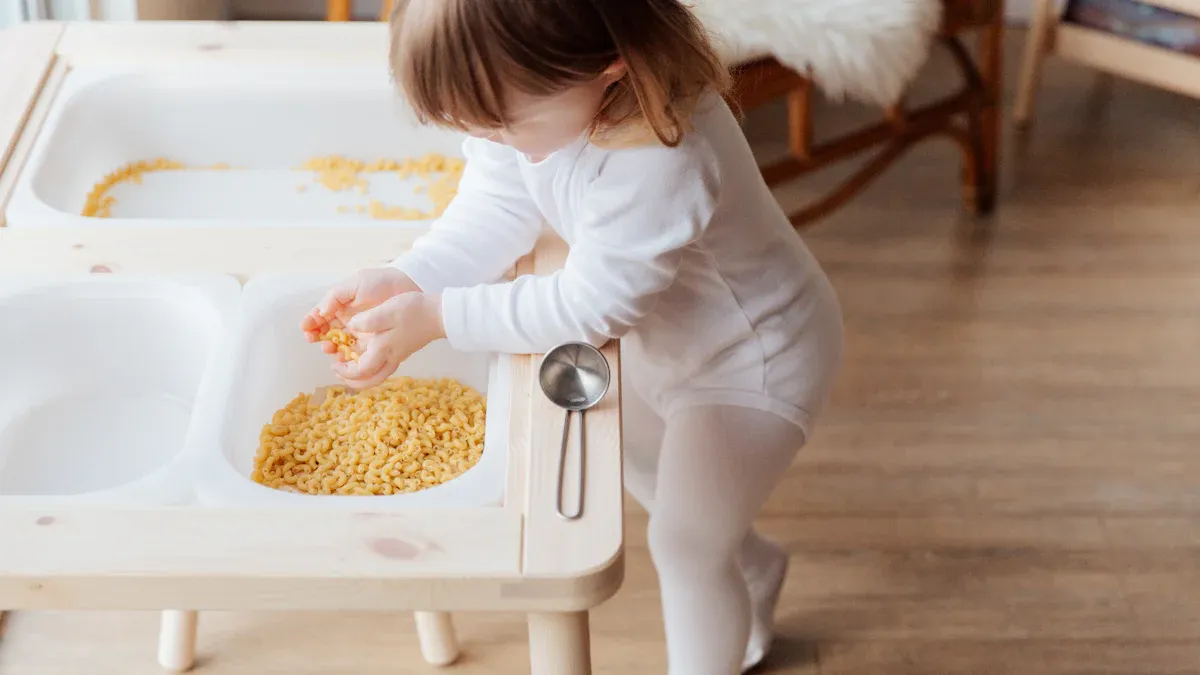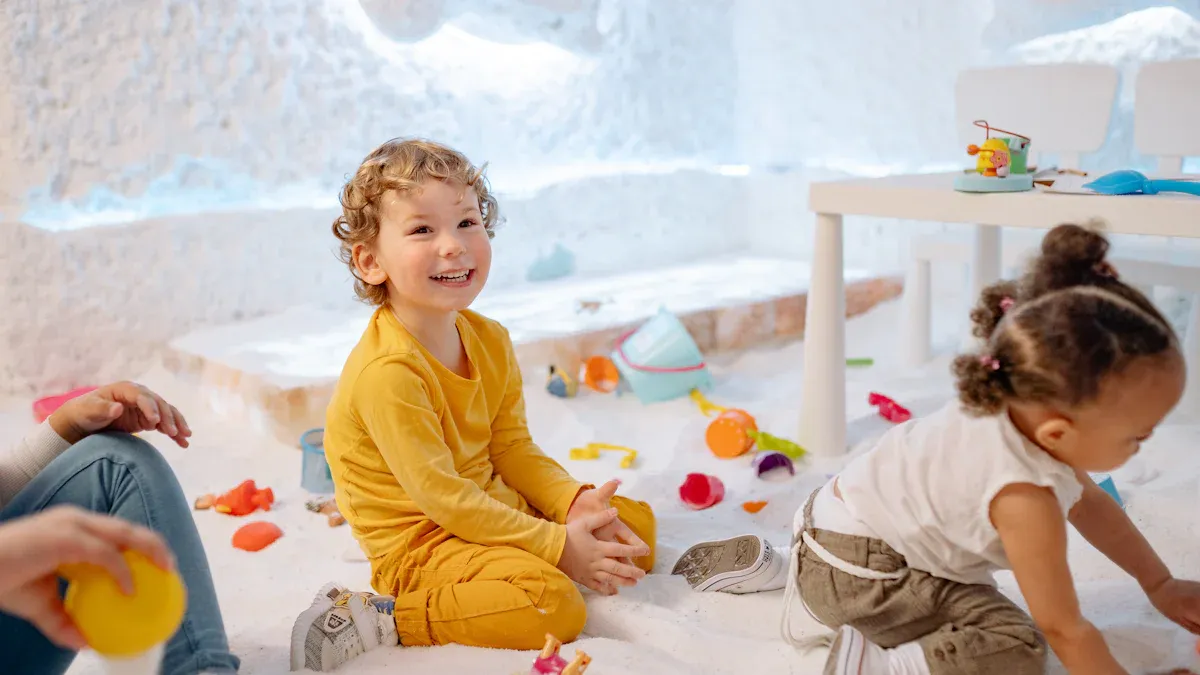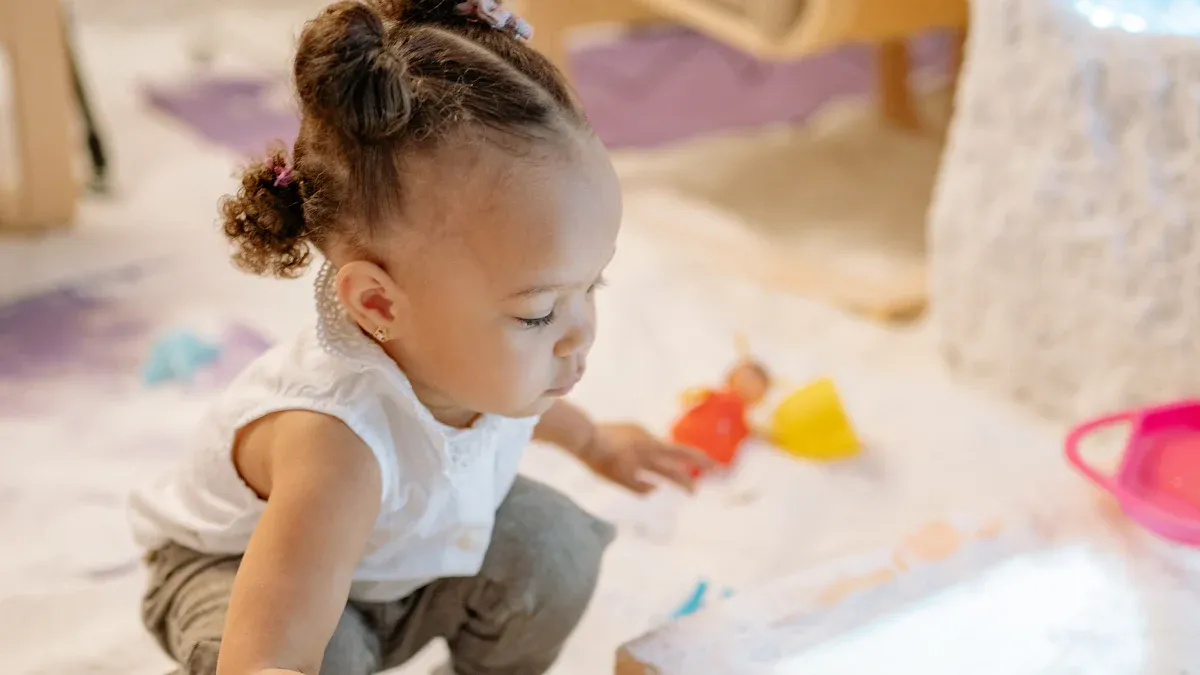Top 10 Non-Messy Sensory Activities for Nurseries in 2025

Kids really like trying new things. Sensory activities for nursery help kids learn and grow. They also keep your nursery clean and safe. These sensory activities give kids fun ways to explore textures, sounds, and colors. They can do this without making a mess.
Key Takeaways
Non-messy sensory activities help brains grow. They let kids solve problems. Kids learn to think in new ways. They also learn about colors and numbers early.
These activities help small muscle skills. Kids get better at using their hands and eyes together. They pour, scoop, and sort things in sensory bins.
Sensory play helps kids control their feelings. Calm activities help kids relax. Kids learn to handle their emotions. They also learn to share and work with others.
Benefits of Sensory Play
Cognitive Growth
Sensory play helps kids think better. Kids like to touch, see, and hear new things. These activities help them solve problems and use logic. They also help kids get creative. Here is how sensory play helps their minds:
Cognitive Benefit | Description |
|---|---|
Playing with textures, sounds, and colors helps kids solve problems and think clearly. | |
Strengthens Fine Motor Skills | Pouring and squeezing help kids move their hands and eyes together. |
Sparks Creativity and Imagination | Open-ended play lets kids explore and learn in fun ways. |
Supports Emotional Regulation | Calm sensory play helps kids relax when they feel too excited. |
Reinforces Early Learning Concepts | Kids learn colors, numbers, and letters by playing. |
Builds Social Skills | Group play teaches kids to share, wait their turn, and talk to friends. |
Studies show sensory play helps the brain grow. When kids explore, they build memory, language, and problem-solving skills.
Motor Skills
Kids get better at moving their hands and bodies with sensory play. Playing with dry rice, beans, or puzzles helps kids scoop, pour, and stack. These activities help fine and big movements. Non-messy play also helps kids focus and use their eyes and hands together.
Sensory bins with dry things help small hand movements.
Stacking toys and puzzles help kids think and move together.
Social and Emotional
Sensory play helps kids handle feelings and work with others. Sharing bins or taking turns with toys teaches patience and talking. Soft fabrics or water bead bags help kids feel calm and safe.
Sensory play helps kids relax and show feelings.
Playing in groups helps kids work together and learn social skills.
Clean and Safe
You want your nursery clean and safe. Non-messy sensory play makes this simple. Use things like textured fabrics or dry grains. These keep your space neat and safe. Pick items that are safe for kids and not toxic. Clean toys often and check for allergies or choking risks.
Management Strategy | |
|---|---|
Mess management | Use washable surfaces or keep materials in containers. |
Choking hazards | Do not use small parts for little kids. |
Hygiene | Clean toys after each use and throw away food items. |
Overstimulation | Keep play times short and calm. |
Sensory Activities for Nursery

Dry Rice or Bean Sensory Bins
You can set up dry rice or bean sensory bins in your nursery with just a few steps. These bins give children a chance to explore textures, colors, and sounds without making a mess. You only need a container, some dry rice or beans, and a few fun tools. Kids love scooping, pouring, and sorting. This activity helps them build fine motor skills and learn about volume and sorting.
Step | Instruction |
|---|---|
1 | Choose a sensory bin container (boxes, trays, or buckets) based on the number of children and learning objectives. |
2 | Pick a theme that engages the children. |
3 | Choose sensory bin fillers like dry rice, dry beans, or other materials relevant to the theme. |
4 | Add fun tools and objects such as natural materials, tweezers, and toys to enhance the sensory experience. |
You can keep the mess under control by using containers with lids and placing bins on washable mats. Dry rice and beans are easy to clean up if spilled. These sensory activities for nursery support problem solving, emotional regulation, imitation, social skills, language development, and fine motor skills.
Benefit | Description |
|---|---|
Sensory Exploration | Sensory bins provide opportunities for children to explore multiple senses, enhancing their sensory development. |
Intellectual Development | Engaging with sensory bins helps children learn cognitive skills, such as sorting and understanding volume. |
Activities like digging and pouring strengthen hand muscles and improve fine motor skills. |
Play Food Fruit Pies
Play food fruit pies are a fun way for kids to pretend and learn. You can use plastic fruit, felt pieces, or soft fabric to make pies. Give children pie tins and let them fill them with different “fruits.” This activity helps kids sort by color, count pieces, and use their imagination. You can set up a pie-making station on a table. Everything stays neat and tidy. You can wash the play food easily, so cleanup is quick.
Tip: Rotate the types of play food each week to keep the activity fresh and exciting for your group.
Egg Collecting Game
The egg collecting game brings sensory exploration to your nursery without any mess. You fill plastic eggs with different materials, like beads, rice, or bells. Hide the eggs in a bin or around the room. Kids search for eggs and discover new textures and sounds. This game helps them learn about weight, sound, and touch. You can keep the activity contained in a sensory bin or a play area, so cleanup is easy.
Spiderweb Maze with Yarn
You can create a spiderweb maze using yarn and chairs or tables. Stretch yarn across a small space to make a web. Kids crawl, step, or reach through the web to find hidden objects or “spiders.” This activity helps children practice problem-solving and critical thinking. It also teaches them about the world around them. The yarn maze stays tidy and does not leave any mess behind.
Children learn to move their bodies in new ways.
They build confidence by solving problems and finding their way through the maze.
Fall-Themed Sensory Bins
Fall-themed sensory bins bring the colors and textures of autumn into your nursery. You can use dried beans, leaves, pinecones, and small pumpkins. Place a plastic tablecloth or shower curtain under the bin to catch spills. Kids love picking out materials and helping set up the bin. You can store items in labeled containers for quick setup and takedown.
Materials | Setup Instructions |
|---|---|
Dried beans | Use a large plastic tablecloth or shower curtain under the bin to catch spills. |
Natural items (leaves, etc.) | Involve your child in setting up the bin—they’ll love picking out materials. |
Handheld vacuum | Take the bin outside for easy cleanup on sunny days. |
Labeled containers | Store all sensory bin items in labeled containers for quick setup and takedown. |
Current trends show that autumn-scented play dough, fall sensory soup, slimy spaghetti, apple-scented cloud dough, edible eyeballs, Halloween aquafaba, and leafy adventures are popular sensory activities for nursery. These activities use natural elements and safe materials, making them easy to clean up.
Sensory Bottles
Sensory bottles are a favorite in many nurseries. You fill clear plastic bottles with water, glitter, beads, or small toys. Kids shake, roll, and watch the items move inside. These bottles help children calm down and focus. You can make sensory bottles for different themes, like ocean, space, or rainbow. They are easy to store and clean, so you do not have to worry about spills.
Note: Always seal the lids tightly with glue or tape to keep the contents inside and avoid leaks.
Bubble Wrap Painting
No mess bubble wrap painting gives kids a chance to explore textures and patterns. You tape bubble wrap to a table and let children press paper or fabric onto it. Use washable markers or stamp pads instead of paint. Kids see fun patterns and feel the bubbles pop under their fingers. This activity keeps your nursery clean and lets kids be creative. You can reuse the bubble wrap for many sessions.
No mess bubble wrap painting is perfect for sensory activities because it does not require water or messy paint. You can set up and clean up in minutes.
Pipe Cleaner Pull Boxes
Pipe cleaner pull box activities help kids build fine motor skills. You poke holes in a cardboard box and thread pipe cleaners through. Children pull, twist, and bend the pipe cleaners. This activity is quiet and mess-free. You can change the colors and shapes of the pipe cleaners to match your theme. Pipe cleaner pull box activities are easy to set up and store.
Kids learn to use their fingers and hands in new ways.
You can add beads or rings for extra challenge.
Water Bead Bags
Water bead sensory bag activities let kids squish and squeeze without any mess. You fill a strong plastic bag with water beads and seal it tightly. Kids press and move the beads around inside the bag. This activity helps them explore texture and color. You can tape the bag to a table or window for group play. Water bead sensory bag activities are safe and easy to clean up.
Edible Kinetic Sand
Edible kinetic sand is a safe and fun sensory activity for nursery. You mix flour, oil, and food coloring to make sand that kids can mold and shape. This sand does not stick to hands or clothes. You can use cookie cutters, cups, and spoons for play. Edible kinetic sand is perfect for toddlers because it is non-toxic and easy to clean. You can store it in a sealed container for future use.
Tip: Make small batches and replace the sand often to keep it fresh and safe for your group.
Sensory activities for nursery do not have to be messy. You can use these ideas to create a clean, safe, and fun learning environment. Try different sensory activities each week to keep children engaged and excited. You will see them grow, learn, and enjoy every moment.
Adapting Sensory Activities
For Different Ages
You can change sensory activities for any age group. Babies and toddlers need different things to stay safe and have fun. Try these ideas:
Infants (6-12 months): Use soft sponges with water. Give them mirrors so they can see themselves. Let them touch ice cubes to help hand-eye coordination. Musical toys help them listen to new sounds. Make sure all items are big and easy to grab.
Toddlers (12-18 months): Give them taste-safe sensory bases and oobleck. Use arts and crafts with things they can eat. Sensory jars with bright objects are fun. Let them touch, squeeze, and shake the items.
Tip: Watch how kids act during play. If they look bored or upset, try a new activity or add new textures and colors.
For Group or Solo Play
You can plan sensory activities for one child or many. For solo play, give each child their own bin or bottle. This helps them focus and explore by themselves. For group play, use big bins or stations so kids can share and play together. Change the materials often to keep things interesting.
Play Type | Setup Ideas |
|---|---|
Solo | Give each child their own bag, bottle, or tray. |
Group | Use big bins, shared stations, or themed tables. |
Safety Tips
Safety is always important in sensory play. You want every child to have fun and stay safe. Here are some main points:
Always watch children during sensory activities. Stay close and help them play.
Know your materials. Only use clean, non-toxic items that are safe for kids.
Teach simple rules. Show kids how to use things gently and safely.
Note: Check for allergies before using new materials. Clean up right after play to keep your nursery safe and neat.
DIY Sensory Activities

Easy Materials
You do not need fancy supplies to create diy sensory activities that kids love. Many toddler-friendly items already sit in your home or classroom. You can use sand, beads, colored rice, or even flour. These materials are easy to set up and safe for little hands. Try filling a fabric pull box with soft scarves or ribbons. Kids will love pulling out the fabric and feeling the different textures. You can also make a feely bag with buttons, beans, or small toys. These easy sensory activities help children build fine motor skills and boost their creativity.
Here are some simple ideas you can try:
Sand play with a small tray and cups
Beads for stringing or sorting
Playing with sound using homemade shakers
Colored rice in a bin for scooping
Nature smells with herbs or flowers
Tip: Let kids help pick the materials. This makes the activity even more fun to explore!
Budget-Friendly Ideas
You can create diy sensory activities without spending much money. Many fun projects use recycled or everyday items. For example, a fabric pull box only needs a cardboard box and old scarves. You can also set up a bottle bowling game with empty plastic bottles and a soft ball. These activities keep costs low and spark creativity.
Activity Name | Description | Common Materials Used |
|---|---|---|
Fabric Pull Box | Pull scarves or fabric strips from a box | Cardboard box, old scarves |
Bottle Bowling Game | Knock down bottles with a ball | Plastic bottles, soft ball |
Crate Block Builders | Build towers with crates or boxes | Milk crates, cardboard boxes |
Recycled Musical Wall | Make music with pots and pans | Old pots, pans, metal lids |
DIY sensory activities give you a chance to bond with children and support their growth. You can use what you have and still create something special.
Non-messy sensory play gives your nursery a boost. You help kids grow smarter, calmer, and more creative. Studies show these activities build strong brains and help children handle feelings. Try new ideas like sorting stones or threading beads. Keep exploring—sensory play can always be safe, fun, and fresh!
FAQ
What if my nursery has children with allergies?
Always check for allergies before you start. Use hypoallergenic materials. You can swap out items like beans or flour for safe alternatives.
How do I keep sensory activities clean?
You can use trays, bins, or zip bags to contain materials. Wipe surfaces after play. Store items in labeled containers for easy cleanup.
Can I reuse sensory materials?
Yes! You can reuse most items like rice, beans, or fabric. Just make sure you clean and dry them before the next use. ♻️
See Also
Essential Sensory Strategies for Kids' Heavy Work Activities
Ten Engaging Sensory Activities for Preschool Learning Adventures
A Comprehensive Resource for Sensory Play Ideas in Education
